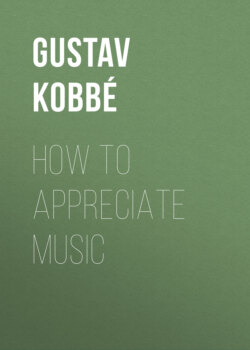Читать книгу How to Appreciate Music - Gustav Kobbé - Страница 17
На сайте Литреса книга снята с продажи.
BACH’S SERVICE TO MUSIC
ОглавлениеTable of Contents
So important has been the rôle played by the pianoforte in the evolution of music that it is possible in these chapters on a pianoforte recital to give a general survey of the art, and thus prepare the reader to enjoy not only what he will hear at such a recital, but enable him to approach it with a more comprehensive knowledge than that would imply. This is one reason why I elected to lead with the chapters on the pianoforte instead of with those on the orchestra, as usually is done, because the orchestra is something “big.” In point of fact, however, the pianoforte, so far as its influence is concerned, is quite as “big,” if not, indeed, bigger than the orchestra; for often, in the evolution of music (as I pointed out in the previous chapter), this instrument, which is so sufficient in itself, has led the orchestra. In reviewing a pianoforte recital it therefore is quite possible to review many phases of musical history.
Take as an example a composition by Bach, one of the preludes and fugues from “The Well-Tempered Clavichord,” with which a pianoforte recital is quite apt to open. The selection illustrates a whole epoch in music which Bach rounded off and brought alike to its climax and its close. You will be apt to find this 49 fugue rather complicated and, I fear, somewhat unintelligible, and this makes it necessary for me to point out at once that in some respects music has had a curious development. A Wagner music-drama, a Richard Strauss tone poem, seem elaborate and complicated affairs compared with a Beethoven sonata or symphony. Yet even the most advanced work of a Wagner or Strauss is neither as complicated nor as elaborate as a fugue by that past master of his art, Johann Sebastian Bach, who, although he was born in 1685 and did not live beyond the middle of the following century, was so far ahead of his age that not even to this day has he fully come into his own. The result is that the early classicists, Haydn and Mozart, who belong in point of time to a later epoch, may more readily be reckoned as “old-fashioned” than Father Bach. When at a recital you listen to a fugue by Bach and find it hard and labored—many people regard it simply as a difficult species of finger exercises—you think that is because it is so very ancient, something in the same class with Greek or Sanscrit. In point of fact it is because in some respects it is so very modern.
Were it not for the importance of preserving an orderly historical sequence in a book of this kind, and that Bach usually is found at the beginning of a recital program, it would be almost more practical, and certainly far easier, for the author to leave Bach until later. When you write of Mozart, or of Beethoven and the moderns, you can depend upon more or less familiarity with their works on the part of your readers, whereas, comparatively few laymen know much about Bach. They associate the name with all that is formal 50 and labored. Yet among my acquaintances is a young woman who was brought up in a very musical family, and who, having as a child heard her mother play the preludes and fugues of the “Well-Tempered Clavichord,” finds Bach as simple as the alphabet. But hers is a most exceptional case. The appreciation of Bach, as a rule, comes only with advanced age. My music teacher used to say to me: “You rave over Schubert and Wagner now, but when you get to be as old as I am you will go back to Father Bach.” While I cannot say that his prophecy has come true, while I still am ultra-modern in my musical predilections, my musical gods being Schubert, Chopin, Schumann, Liszt, Brahms, Richard Strauss and, above all, Wagner, I should consider myself unfit to write this book if I failed to realize the debt modern music owes to Bach, and that the more modern the music the greater the debt.
